 W
WThe Ameprod Television Game 10 is a dedicated first-generation home video game console that was produced in Poland by Elwro from 1978 to 1981. In 1981, the production was transferred to PPZ Ameprod. In 1980, the system was released by PPZ Ameprod. In the first three years, about 10,000 consoles were sold. In 1984, the production ended and about 100,000 Ameprod TVG-10 consoles were sold.
 W
WThe APF TV Fun brand is a series of dedicated home video game consoles manufactured by APF Electronics Inc. and built in Japan starting in 1976. The systems were among the first built on the General Instrument "Pong-on-a-chip", the AY-3-8500, that allowed many manufacturers to compete against the Atari Home Pong. The APF TV Fun consoles were one of the earliest pong clone consoles.
 W
WThe BSS 01, also known as RFT TV-Spiel or simply TV-Spiel, is a dedicated first-generation home video game console that was released in 1980 or 1981 only in East Germany. It was manufactured between 1979 and 1980 by VEB Halbleiterwerk Frankfurt (Oder) and is credited the only video game console that was released in East Germany. Due to its high price, it rarely succeeded in private households and mostly delivered to youth centers, leisure and educational institutions.
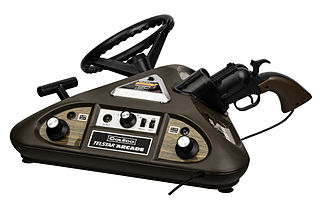 W
WThe Coleco Telstar Arcade, commonly abbreviated as Telstar Arcade, is a first-generation home video game console that was released in 1977 in Japan, North America and Europe by Coleco. It is the most advanced video game console in the Coleco Telstar series, based on the MOS Technology MPS-7600-00x chips series. Each of these chips is a full microcontroller with 512 ROM area.
 W
WThe Coleco Telstar Marksman, commonly abbreviated as Telstar Marksman, is a first-generation home video game console that featured a light gun. It was released by Coleco in 1978. Because it had a manufacturer-set number of games, it is considered a dedicated console. It was part of the Coleco Telstar series Pong-based home video game consoles; it is essentially a Coleco Telstar Colortron bundled with a "3 in 1" light gun and two shooting games. The Marksman light gun is a pistol that features an attachable stock and barrel. It is similar in this regard to the later-released Stack Light Rifle and the Sega Menacer. The elongated barrel included a simple aiming sight. In addition to the light gun, the system featured two paddle controllers built directly into the console. Its reported features included "on-screen digital scoring" and three different difficulty settings. It required two nine-volt batteries or Coleco's Perma Power AC adaptor to power the system.
 W
WThe Coleco Telstar brand is a series of dedicated first-generation home video game consoles produced, released and marketed by Coleco from 1976 to 1978. Starting with Coleco Telstar Pong clone based video game console on General Instrument's AY-3-8500 chip in 1976, there were 14 consoles released in the Coleco Telstar series. About one million units of the first model called Coleco Telstar were sold.
 W
WThe Color TV-Game series of five dedicated home video game consoles was created by Nintendo and released in Japan only. Nintendo sold three million units of the first four models: one million units of each of the first two models, Color TV-Game 6 and 15; and half a million units of each of the next two models, Block Breaker and Racing 112. The Color TV-Game series has the highest sales figures of all the first generation of video game consoles. The systems can run on C batteries or an AC adapter. It is also the first console to be released by Nintendo.
 W
WThe Colorsport VIII is a dedicated first-generation monochromatic home video game console made available to consumers in 1978 by Granada Electronics in the United States. The console is based on the MOS Technology MPS 7600-001 Pong-on-a-chip like the Coleco Telstar Arcade console.
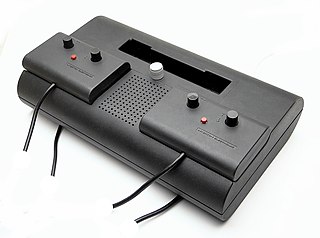 W
WThe Interton Video 2000 is a relatively rare dedicated first-generation home video game console that was released in 1975 by Interton in Germany. The console turns itself on automatically when a cartridge is inserted. This console was also one of the first cartridge-based consoles ever released in Europe.
 W
WThe Interton Video 2400 is a dedicated first-generation home video game console that was released in 1975 by Interton. It is the successor of the Interton Video 2000 and the predecessor of the Interton Video 2501. It could output only black and white. The consoles uses the AY-3-8500 chipset. The sound is played through an internal speaker, rather than the TV set.
 W
WThe Interton Video 2501 is a dedicated first-generation home video game console that was released by Interton in 1977. It is the successor of the Interton Video 2400 and the predecessor of the Interton Video 2800. It can output the games in color.
 W
WThe Interton Video 2800 is a dedicated first-generation home video game console that was released in 1977 by Interton. It could output only black and white. It is the successor of the Interton Video 2501 and the predecessor of the Interton Video 3000.
 W
WThe Interton Video 3000 is a dedicated first-generation home video game console that was released in Germany in 1976 by German manufacturer Interton and sold by Quelle. Due to the AY-3-8500 chipset from General Instrument, the console has six integrated games: Tennis, Football, Practice, Squash, Skeet and Moving target. It had a list price of 198 Deutsche Mark (DM).
 W
WThe Interton Video 3001 is a dedicated first-generation home video game console that was released in 1978 by Interton. It is a Pong clone console and the successor to the Interton Video 3000 and the predecessor of the Interton Video Computer 4000. It could output games in color.
 W
WThe Magnavox Odyssey is the first commercial home video game console. The hardware was designed by a small team led by Ralph H. Baer at Sanders Associates, while Magnavox completed development and released it in the United States in September 1972 and overseas the following year. The Odyssey consists of a white, black, and brown box that connects to a television set, and two rectangular controllers attached by wires. It is capable of displaying three square dots and one line of varying height on the screen in monochrome black and white, with differing behavior for the dots depending on the game played. Players place plastic overlays on the screen to display additional visual elements for each game, and the one or two players for each game control their dots with the knobs and buttons on the controller in accordance with the rules given for the game. The console cannot generate audio or track scores. The Odyssey console came packaged with dice, paper money, and other board game paraphernalia to accompany the games, while a peripheral controller—the first video game light gun—was sold separately.
 W
WThe PC-50x Family is a series of home video game consoles belonging to the first generation prevalent in Europe between 1975 and the early 1980s, all produced in Asia. The designation PC-50x of the series derives from the name of the cartridges.
 W
WThe Ping-O-Tronic is a dedicated first-generation home video game console produced by Zanussi, an Italian home appliance company, and released under their Sèleco brand in late-1974 only in Italy. It was the first Italian video game console, excluding Magnavox Odyssey imports and clones.
 W
WPong is a table tennis–themed arcade video game, featuring simple two-dimensional graphics, manufactured by Atari and originally released in 1972. It was one of the earliest arcade video games; it was created by Allan Alcorn as a training exercise assigned to him by Atari co-founder Nolan Bushnell, but Bushnell and Atari co-founder Ted Dabney were surprised by the quality of Alcorn's work and decided to manufacture the game. Bushnell based the game's concept on an electronic ping-pong game included in the Magnavox Odyssey, the first home video game console. In response, Magnavox later sued Atari for patent infringement.
 W
WThe Telejogo is a dedicated first-generation home video game console that was released on August 2, 1977 by Philco and Ford in Brazil. It is a Pong clone console and the first video game console ever released in Brazil. In 1979, a successor called Telejogo II was released.
 W
WThe Telejogo II is a dedicated first-generation home video game console that was manufactured by Philco and Ford and released in 1979 in Brazil as the successor to the 1977 video game console Telejogo.
 W
WThe Telescore 750 is a dedicated first-generation home video game console manufactured and released by Groupe SEB in 1977, only in France for 100 Franc. Two revisions were released afterwards; the Telescore 751 in 1978, identical to the Telescore 750 but with two detachable game controllers and support for a lightgun sold separately, and the Telescore 752 in 1979, which was almost identical to the Telescore 751 but could also display games in color and had the lightgun included.
 W
WThe Turnir is a dedicated first-generation home video game console that was manufactured by the Ministry of the Electronics Industry and released in 1978 only in the Soviet Union. It was manufactured between 1978 and 1982 and is the only known Soviet video game console that uses the AY-3-8500 chipset from General Instrument. The price for the system varied from 150 Soviet rubles in 1978 to 96 rubles in the late 1980s. The console uses an integrated AC adapter with a voltage of 9 volt and has a mass of 2.5 kg.
 W
WThe TV Tennis Electrotennis is a dedicated first-generation home video game console that was released by Epoch Co. in cooperation with Magnavox on September 12, 1975 for 19,000 Japanese yen only in Japan. It was the first video game console ever released in Japan.
 W
WThe TV Vader is a dedicated first-generation home video game console that was released by Epoch Co. in 1980 only in Japan for 15,000 or 16,500 Japanese yen. It is the successor of the 1978 released Cassette TV Game and the predecessor of the Cassette Vision. Due to the integrated NEC D774C chipset, only a colored clone of the 1978 game Space Invaders is playable with the system. A year later, the game was ported for the Cassette Vision under the name Battle Vader.
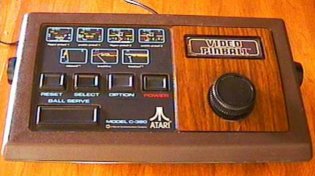 W
WThe Video Pinball brand is a series of first-generation single-player dedicated home video game consoles manufactured, released and marketed by Atari, Inc. starting in 1977. Bumper controllers on the sides or a dial on the front are used to control the games depending on the game selected. There are three game types in the first model of the Video Pinball series: Pinball, Basketball, and Breakout.
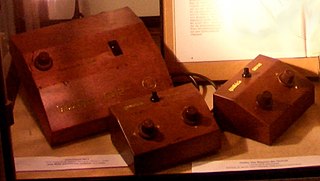 W
WThe VideoSport MK2 is a dedicated home video game console that was produced by Henry's, a British retailer of television and Hi-fi equipment, starting in 1974 or early 1975 until 1977. Customers could purchase the console in stores or have it delivered to them by mail. The original price was £34.72; it dropped to £29.50 in May 1976 and to £20.20 later in 1976 or early 1977. By May 1976, over 10,000 units of the console had been sold.
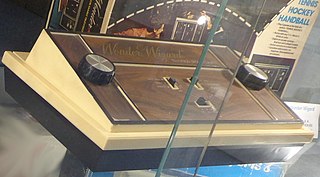 W
WThe Wonder Wizard is a dedicated first-generation home video game console which was manufactured by Magnavox and released by General Home Products in June 1976 only in the United States.